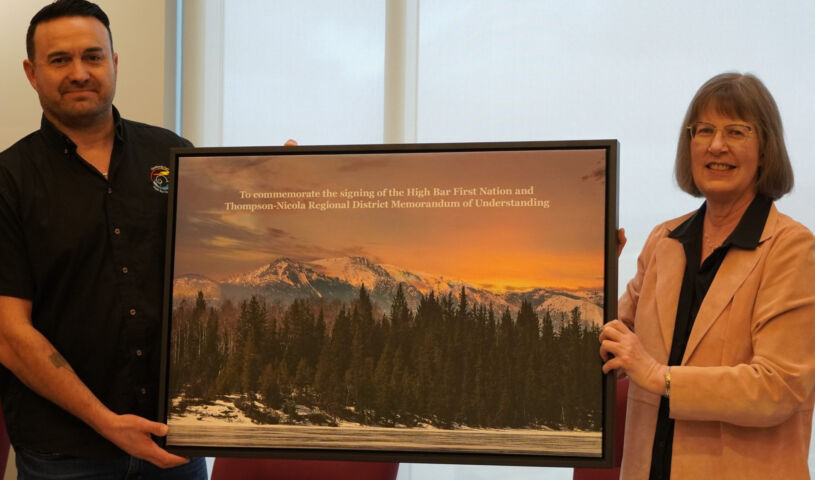Several western municipalities sign Indigenous partnerships
 Jamie Fletcher, Kúkpi7 (Chief) High Bar First Nation and Barbara Roden, board chair Thompson-Nicola Regional District came together to help celebrate the signing of a memorandum of understanding between the two communities. Photo: Thompson-Nicola Regional District
Jamie Fletcher, Kúkpi7 (Chief) High Bar First Nation and Barbara Roden, board chair Thompson-Nicola Regional District came together to help celebrate the signing of a memorandum of understanding between the two communities. Photo: Thompson-Nicola Regional District
Leaders with the Llenllenéy’ten (High Bar First Nation – HBFN) and the Thompson-Nicola Regional District (TNRD) came together on Jan. 10 for a ceremony to sign a Memorandum of Understanding (MOU) aimed at encouraging Reconciliation and to strengthen mutual trust, understanding, and collaboration.
“This agreement recognizes a growing positive relationship between the TNRD and High Bar, and the importance of working co-operatively on matters of shared interests,” said Barbara Roden, TNRD board chair. “Our board is continuing to focus on building partnerships with our many neighbouring First Nations, and we look forward to working with High Bar to address challenges and create opportunities for the region.”
Following the signing ceremony, a community-to-community forum was held between the district and High Bar leadership, including members of High Bar council, the regional district’s board chair, and directors of Electoral Areas “E” (Bonaparte Plateau) and “I” (Blue Sky Country), as well as staff from each government.
“The High Bar community is pleased to formalize the working relationship we have already developed with the TNRD with this MOU,” said HBFN Kúkpi7 (Chief) Jamie Fletcher. “High Bar is progressive and forward-thinking in our approach to building relationships with other orders of government. We look forward to building upon our existing co-operative work on emergency management with the TNRD, and to working with them to build a strong, inclusive, and resilient regional community.”
The district’s board of directors prioritized engaging with First Nations in its 2023-2026 strategic plan, which has relationships and Reconciliation as a key priority.
For High Bar, the district MOU is the latest important milestone in its growing relationship with municipal governments. In 2024, HBFN signed an MOU with the Village of Clinton, developed a joint Emergency Management Cooperation and Communication Protocol with Clinton and the TNRD, and joined the Union of BC Municipalities as an Indigenous member.
Regina and First Nations University
TNRD is not the only municipality to recently sign an MOU to enhance collaboration with Indigenous communities. In September 2024, First Nations University of Canada (FNUniv) and the City of Regina officially signed a MOU. The agreement was signed by FNUniv President, Dr. Jacqueline Ottmann, and then-Regina mayor Sandra Masters during a special ceremony.
“We are eager to embark on this new partnership to create more opportunities for educational and cultural growth that will enrich our entire community,” Masters said. “I am grateful to the First Nations University of Canada for their leadership and commitment to collaboration in Regina.”
In a statement, FNUniv said the MOU reflected a commitment to advance Reconciliation efforts.
Ottmann said the MOU between First Nations University of Canada and the City of Regina formalizes and publicly demonstrates a commitment to good relations, one that has been forged over time.
“In February 2019, the land that FNUniv resides on became atim kâ-mihkosit in Cree, or ‘Red Dog,’ and part of Starblanket Cree Nation,” Ottmann said. “For the last 48 years, we have been neighbours with the City of Regina, and people from FNUniv and the City of Regina have collaborated in numerous ways.”
The MOU is a non-legally binding agreement that is aimed at fostering collaboration in how joint initiatives are identified and pursued. Key aspects of the agreement include annual meetings to discuss strategic priorities, establishing action committees to ensure progress is made on initiatives, and collaborating on public announcements and messaging.
The MOU is in effect for four years, with both parties committed to an annual review to assess its impact and explore opportunities for renewal.
Gitxsan Huwilp, Kitimat-Stikine Develop MOU
On Dec. 11, 2024, the Gitxsan Huwilp Government and the Regional District of Kitimat-Stikine (RDKS) also developed an MOU and held a signing ceremony at the Upper Skeena Recreation Centre in Hazelton.
The MOU is based on guiding principles, which include providing a foundation for establishing and maintaining a co-operative government-to-government relationship and establishing a framework for meaningful communication and information sharing. It also acknowledges that the boundaries of the regional district include lands that form Gitxsan traditional territory, and each government has distinct authorities and responsibilities toward their residents and that the best interest of everyone in the communities are best served by working together.
“This MOU marks a meaningful step toward strengthening our relationship with the Regional District of Kitimat-Stikine,” said Simoyghet Gwiiyeehl (Hereditary Chief) Brian Williams, a member of the Gitxsan Huwilp government and one of the leaders of the Gitxsan Nation. “As we continue to build trust and work together, we honour the wisdom of our ancestors, ensuring our voice is heard and we actively participate in decisions that impact our traditional lands and our people. This partnership is a positive reflection of what can be achieved when we come together with respect and unity.”
The impetus to draft the MOU came from a request from the Gitxsan Huwilp government to have a seat on the RDKS Board of Directors. The subsequent document was developed as a first step toward forming a partnership through communications and collaboration.
“An important part of the RDKS strategic plan is to advance Reconciliation through First Nations participation in regional governance, partnerships, and collaboration, so this MOU is a promising first step,” said Cyra Yunkws, RDKS board chair. “We are deeply pleased to demonstrate the commitment to collaborate with the Gitxsan First Nation. We are excited about the possibilities that lie ahead and see our future together as very positive.”
The date of the signing ceremony coincided with Delgamuukw Day, a significant and historic day for the Gitxsan and other First Nations.
On Dec. 11, 1997, the Supreme Court of Canada unanimously passed it’s Delgamuukw judgment. The ruling confirmed the existence of Aboriginal Title and provided important definition and description of Aboriginal title. It also affirmed the legal validity of Indigenous oral history and clarified Canada’s duties to consult Indigenous Peoples. MW
✯ Municipal World Executive and Essentials Plus Members: You might also be interested in Heidi Redman’s article: Tse’k’wa amphitheatre: Storytelling in outdoor spaces.
Ibrahim Daair is staff writer at Municipal World.
Related resource materials:



